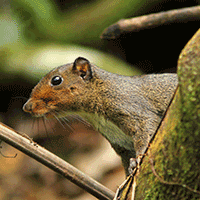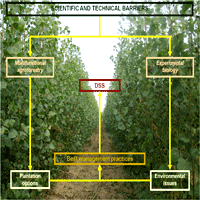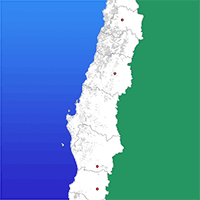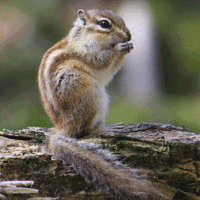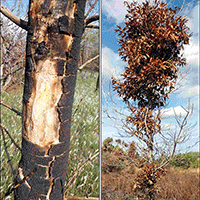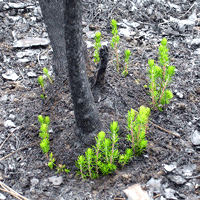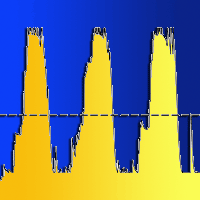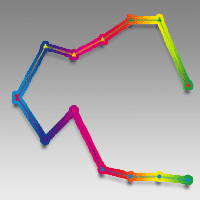
Outplanting performance of three provenances of Quillaja saponaria Mol. established in a Mediterranean drought-prone site and grown in different container size
Sergio E Espinoza (1) , Marco A Yañez (2), Carlos R Magni (3), Rómulo E Santelices (1), Antonio M Cabrera (4)
iForest - Biogeosciences and Forestry, Volume 13, Issue 1, Pages 33-40 (2020)
doi: https://doi.org/10.3832/ifor3142-012
Published: Jan 21, 2020 - Copyright © 2020 SISEF
Research Articles
Abstract
In degraded environments with restricted seed availability, like those burned by wildfires in central Chile during 2017, the use of plant material from outside its area of origin for restoration purposes needs to be accurately investigated. We assessed the early development of three Chilean provenances of Quillaja saponaria grown in different container sizes (140 vs. 280 mL) in the nursery and then outplanted in a common field trial at a site severely affected by fire under Mediterranean-type climate. We analyzed growth, biomass, and leaf-level physiological traits. In the nursery, there was a significant provenance by container type interaction for the biomass traits (P < 0.05). Seedlings from the Maule provenance cultivated in larger containers had the highest biomass, while the lowest biomass was observed for the Metropolitan provenance cultivated in small containers. Two years after outplanting, the provenance by container size interaction was significant for stomatal conductance and chlorophyll density. Seedlings from the Metropolitan provenance cultivated in larger containers exhibited a higher stomatal conductance, while those from the Maule provenance cultivated in small containers exhibited the highest chlorophyll density. Seedling height showed significant variation for provenance and container size. The tallest seedlings were those grown in larger containers from the Maule provenance; however, no differences in survival and height increment were found. Gas exchange parameters differed among provenances, the Metropolitan provenance had a low performance and the opposite was found for the Biobío and Maule provenances. This study demonstrated that different provenances of Q. saponaria have stable performances in a Mediterranean site, which support their use for restoration purposes outside their home area with no detrimental effects on outplanting performance.
Keywords
Restoration, Quillay, Dry Site, Water Stress, Pot Size, Seed Origin
Authors’ Info
Authors’ address
Rómulo E Santelices 0000-0002-5790-8701
Universidad Católica del Maule, Facultad de Ciencias Agrarias y Forestales, Avenida San Miguel 3605, Talca (Chile)
Núcleo Científico Multidisciplinario, Universidad de Talca, 2 Norte 685, P.O. Box 747, Talca (Chile)
Universidad de Chile, Facultad de Ciencias Forestales y de la Conservación de la Naturaleza, Avenida Santa Rosa 11365, La Pintana (Chile)
Universidad Católica del Maule, Vicerrectoría de Investigación y Posgrado, Avenida San Miguel 3605, Talca (Chile)
Corresponding author
Paper Info
Citation
Espinoza SE, Yañez MA, Magni CR, Santelices RE, Cabrera AM (2020). Outplanting performance of three provenances of Quillaja saponaria Mol. established in a Mediterranean drought-prone site and grown in different container size. iForest 13: 33-40. - doi: 10.3832/ifor3142-012
Academic Editor
Gianfranco Minotta
Paper history
Received: May 03, 2019
Accepted: Nov 05, 2019
First online: Jan 21, 2020
Publication Date: Feb 29, 2020
Publication Time: 2.57 months
Copyright Information
© SISEF - The Italian Society of Silviculture and Forest Ecology 2020
Open Access
This article is distributed under the terms of the Creative Commons Attribution-Non Commercial 4.0 International (https://creativecommons.org/licenses/by-nc/4.0/), which permits unrestricted use, distribution, and reproduction in any medium, provided you give appropriate credit to the original author(s) and the source, provide a link to the Creative Commons license, and indicate if changes were made.
Web Metrics
Breakdown by View Type
Article Usage
Total Article Views: 42392
(from publication date up to now)
Breakdown by View Type
HTML Page Views: 35864
Abstract Page Views: 3107
PDF Downloads: 2648
Citation/Reference Downloads: 4
XML Downloads: 769
Web Metrics
Days since publication: 2173
Overall contacts: 42392
Avg. contacts per week: 136.56
Citation Metrics
Article Citations
Article citations are based on data periodically collected from the Clarivate Web of Science web site
(last update: Mar 2025)
Total number of cites (since 2020): 5
Average cites per year: 0.83
Publication Metrics
by Dimensions ©
Articles citing this article
List of the papers citing this article based on CrossRef Cited-by.
References
Seed provenance for restoration and management: conserving evolutionary potential and utility. In: “Genetic Considerations in Ecosystem Restoration using Native Tree Species” (Bozzano M, Jalonen R, Thomas E, Boshier, D, Gallo L, Cavers S, Bordács S, Smith P, Loo J eds). FAO, Rome, Italy, pp. 27-33.
Gscholar
Análisis de la afectación y severidad de los incendios forestales ocurridos en enero y febrero de 2017 sobre los usos de suelo y los ecosistemas naturales presentes entre las regiones de Coquimbo y Los Ríos de Chile [Analyses of effects and severity of the 2017 fires on land use and nature ecosystems in the Coquimbo and Los Ríos Chilean administrative regions]. Informe Técnico, Corporación Nacional Forestal, Santiago, Chile, pp. 51. [in Spanish]
Gscholar
Quillaja saponaria Mol. Quillay Familia: Quillajaceae. In: “Las Especies Arbóreas de los Bosques Templados de Chile y Argentina” [The Woody Species of the Temperate Forests of Chile and Argentina] (Donoso C ed). Autoecología. Marisa Cuneo Ediciones, Valdivia, Chile, pp. 545-555. [in Spanish]
Gscholar
International rules for seed testing. International Seed Testing Association (ISTA). Bassersdorf, Switzerland.
Gscholar
Local adaptation enhances performance of common plant species. Ecological Letters 4: 536-544.
CrossRef | Gscholar
Nursery fertilization enhances survival and physiological status in Canary Island pine (Pinus canariensis) seedlings planted in a semiarid environment. European Journal of Forest Research 128: 221-229.
CrossRef | Gscholar
Fertilizer location modifies root zone salinity, root morphology, and water stress resistance of tree seedlings according to the watering regime in a dryland reforestation. Journal of Plant Nutrition and Soil Science 179: 223-233.
CrossRef | Gscholar
Plasticity, instability and canalization: is the phenotypic variation in seedlings of sclerophyll oaks consistent with the environmental unpredictability of Mediterranean ecosystems? New Phytologist 156: 457-467.
CrossRef | Gscholar
Increase in size and nitrogen concentration enhances seedling survival in Mediterranean plantations. Insights from an ecophysiological conceptual model of plant survival. New Forests 43: 755-770.
CrossRef | Gscholar



